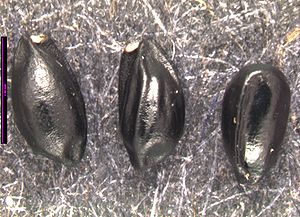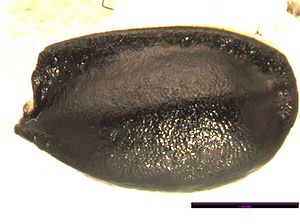Difference between revisions of "Aquilegia formosa"
| Line 6: | Line 6: | ||
'''Measurement:''' 2.5 x 1.4 x 1.2 | '''Measurement:''' 2.5 x 1.4 x 1.2 | ||
| − | + | ====Features==== | |
| − | Seed is glossy and lightly textured with very small bumps. | + | '''Shape:''' Seeds tapering at hilium end, broadening at opposite side. |
| + | |||
| + | '''Color:''' Hilum is white, seed is black. | ||
| + | |||
| + | '''Surface:''' At least one distinct ridge runs from the hilum to the opposite side. End opposite hilum is sometimes puckered or having concave pits. Seed is glossy and lightly textured with very small bumps. | ||
'''Latitudinal Cross Section:''' elliptical [[File:AQFO lat.png]] | '''Latitudinal Cross Section:''' elliptical [[File:AQFO lat.png]] | ||
Revision as of 19:01, 27 February 2012
Seed
Abbreviation: AQFO
Seed sample from: 2011
Measurement: 2.5 x 1.4 x 1.2
Features
Shape: Seeds tapering at hilium end, broadening at opposite side.
Color: Hilum is white, seed is black.
Surface: At least one distinct ridge runs from the hilum to the opposite side. End opposite hilum is sometimes puckered or having concave pits. Seed is glossy and lightly textured with very small bumps.
Latitudinal Cross Section: elliptical ![]()
Longitudinal Cross Section: obovate ![]()
Basic Explanations and Assumptions:
The dimensions for the seeds are length x width x depth. The location of the hilum is used as the base of the seed, and the length is measured from hilum to the opposite apex. Where a style is present, the length is measured from the hilum to the bottom of the style. Width is measured at a right angle to the length at the widest part. Depth is measured at a right angle to the intersection of height and width lines.
Measurements included are the mean average for each measurement of ten separate seeds.
All measurements in millimeters unless otherwise noted.


